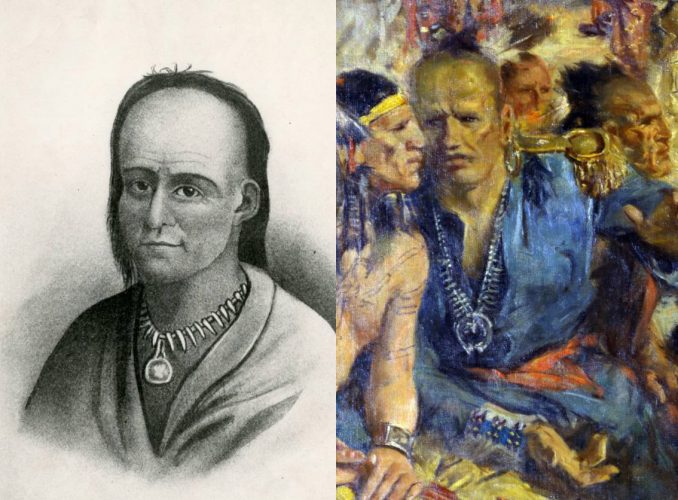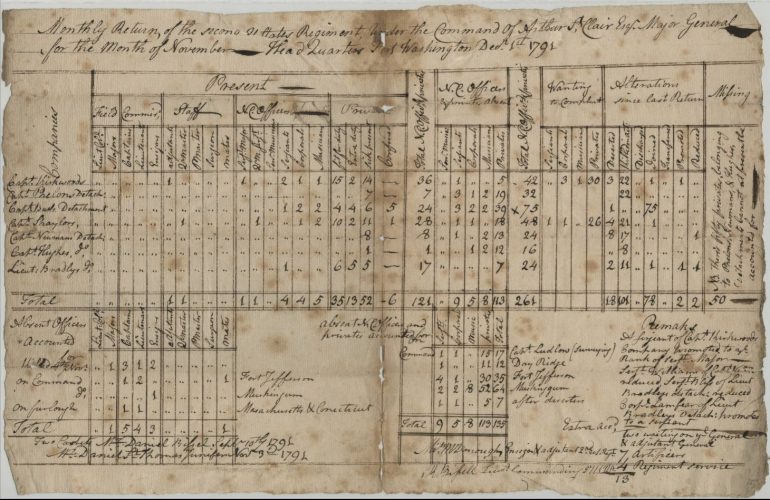Manuscripts in Ohio Memory: A Muster Roll, A Monthly Return, and the Battle of Wabash

A few weeks ago, a State Library of Ohio patron visited and asked to see a collection of archival materials and, in the box, was a muster roll dated October 26, 1791, entitled “A General Abstract of the Troops in the Service of the United States Commanded by His Excellency Arthur St. Clair, Major General and Commander in Chief of the Troops in the Western Territory.” The patron, a history buff, pointed out that the muster roll was taken shortly before a significant event in Ohio history: the Battle of Wabash, also known as St. Clair’s Defeat. Excited about the possibilities, we began researching the document and the battle and realized that what we held in our collection was much more than it seemed.
To understand the document’s importance, a bit of history is in order. In March 1791, Arthur St. Clair, continental soldier and governor of the Northwest Territory, was named commander of the U.S. Army. His top priorities: conquer American Indian nations living in the Northwest Territory and construct forts in what is now western Ohio. He first sent General Josiah Harmar and an army of nearly 1,500 troops to carry out his orders but, in October of 1790, Harmar and his troops were defeated by American Indians led by Shawnee chief Weyapiersenwah (Blue Jacket) and Miami chief Mishikinakwa (Little Turtle).

Thinking that he would be more successful leading the mission himself, St. Clair moved against the American Indians in September of 1791. As the army traveled, they constructed fortresses along the way, first building Fort Hamilton, then Fort Jefferson, arriving at the banks of the Wabash on November 3. Major General Arthur St. Clair and his American army were confronted and soundly defeated by a large alliance of American Indians, led by Weyapiersenwah and Mishikinakwa. This force was comprised of seasoned volunteer warriors from nine different American Indian tribes—the major tribes in the Battle of the Wabash were the Wyandots, Seneca, Cherokee, Ojibwe, Ottawa, Potawatomi, Shawnee, Delaware, and Miami. Together, these nine tribes accounted for the estimated 1,400 warriors on the day of battle.
The battle and catastrophic losses of American troops led to a Congressional investigation and to President Washington demanding St. Clair’s resignation. St. Clair complied and resigned from military service, though he continued to serve as governor of the Northwest Territory until 1802. Congress, meanwhile, determined that “inadequate forces, gross mismanagement by the quartermaster and contractors, and the lack of discipline and experience in the troops” were the cause for the massive defeat.
The muster roll in the State Library’s collection may be the last one taken before the battle; at the time of this writing, no others have been discovered. It shows that 3,222 men in total were under St. Clair’s command and lists names of Army Majors and Captains. It provides a count of who was present for duty, who was sick, who was on command (on daily duty), and who was confined (under arrest). It is a unique snapshot of a moment in time before that day in November.

Remarkably, Ohio Memory also holds a document created just over a month later: Monthly Return of the United States Second Regiment Following St. Clair’s Defeat. It lists thirteen officers killed at the battle, with only eight surviving and only two of those eight being present, and notes that 50 privates were missing when the document was created on December 1, 1791. The two documents, taken together, bookend the Battle of Wabash and present a more complete picture of this event.
For more information on the Battle of Wabash, the National Museum of the United States Army has a detailed article on the fight and its aftermath. Ball State University has completed significant research on both the Battle of the Wabash and the Battle of Fort Recovery in collaboration with various Tribal partners. You can also visit Ohio History Central for more on the battle and on Arthur St. Clair. Ohio Memory has made a number of items related to St. Clair and to the battle available, including an image of a hand-drawn military map; St. Clair’s Orders of March, Battle and Encampment, which he later used as defense during his Congressional investigation; and a sketch of Lieutenant Colonel William Darke, who commanded the left wing of St. Clair’s army and for whom Darke County was later named. Darke is also listed on the muster roll; you’ll find him in the fourth row which is labeled “1st Regiment.” He survived the battle.
In December 1793, Major General Anthony Wayne built a fort at the site of St. Clair’s defeat, named Fort Recovery. The same tribes that defeated St. Clair were part of an even larger American Indian tribal alliance that attacked the Fort on June 30 and July 1, 1794. In the Battle of Fort Recovery, the American forces held, and the American Indians retreated. This American Indian defeat at Fort Recovery, and later at Fallen Timbers in August 1794, marked the end of the period of conflict known as the Northwest Indian War.
Many thanks to State Library of Ohio patron Dan W. for helping us to better understand the treasure in our collection!
Thank you to Shannon Kupfer-Trausch, Digital Initiatives Librarian at theState Library of Ohio, for this week’s post!
Some language in this post was re-used with permission from resources at Ball State University.



Leave a Reply
You must be logged in to post a comment.